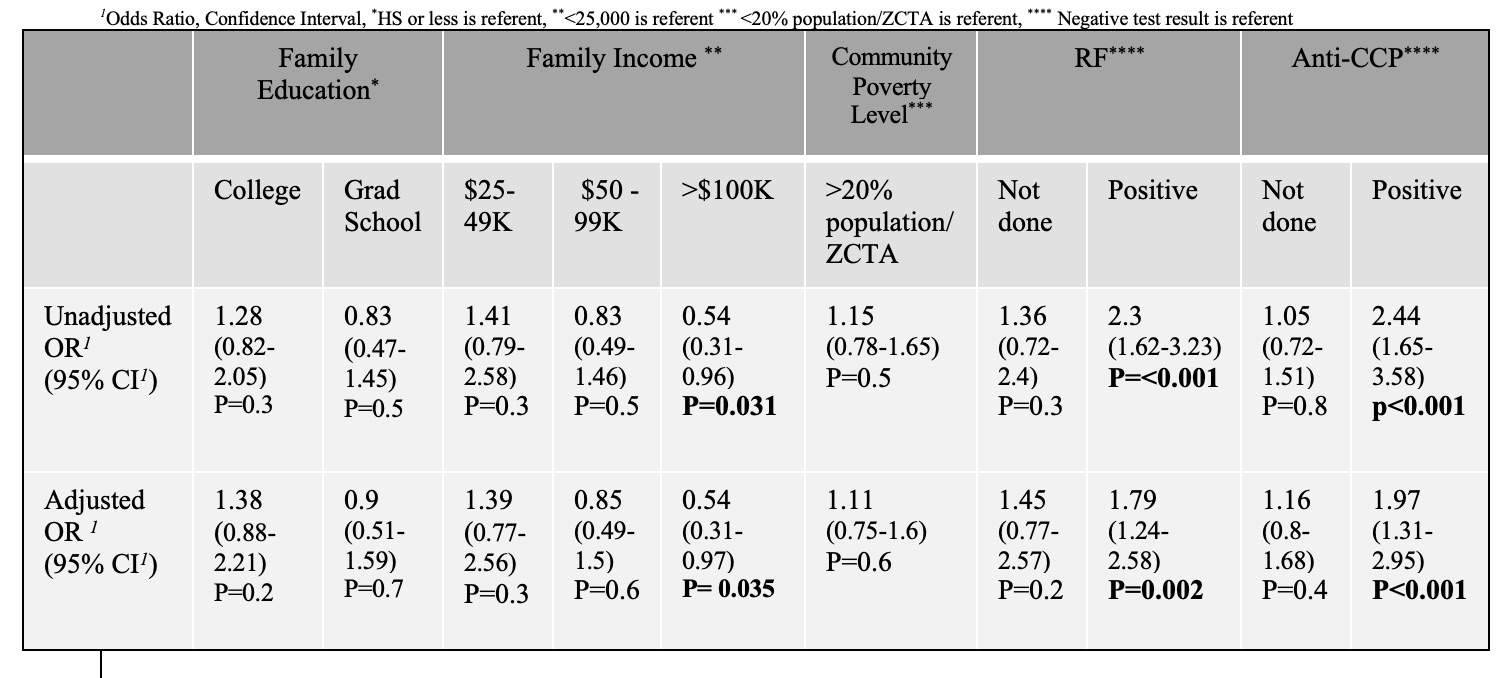Session Information
Session Type: Poster Session B
Session Time: 9:00AM-11:00AM
Background/Purpose: Joint stiffness as a sign of intra-articular inflammation may be an early presenting symptom of JIA. Studies following pain in chronic disease have shown that pediatric patients from lower socioeconomic brackets report less pain compared to severity matched disease in affluent patients, it is unknown if joint stiffness in JIA follows a similar trend. The objective of this study is to assess the relationship between social determinants of health (SDoH) and presence and duration of morning joint stiffness. Polyarticular JIA (pJIA) patients were studied as they are older cohort of patient more likely to accurately describe presence of stiffness.
Methods: We retrospectively analyzed Childhood Arthritis and Rheumatology Research Alliance (CARRA) registry from July 2015 through February 2020. Inclusion criteria were USA residency and pJIA diagnosis with recorded >4 joints involved in first 6 months of disease; exclusion criteria were invalid zip code and additional diagnosis of systemic inflammatory or autoimmune disease. The primary outcomes of interest are presence and duration of morning stiffness. SDoH we studied were reported family income, highest level of completed guardian education, and community poverty level. Demographics, RF and anti-CCP status were included as covariates. Five-digit zip-codes were used to extrapolate community poverty levels using 2014-2018 American Community Survey data. Chi-square tests were utilized to assess the bivariate relationships between SDoH and study outcomes. We used logistic regression models to determine association of SDoH with duration of morning stiffness ( >60min vs < 60min) and adjusted for age at diagnosis.
Results: 1684 patients were included in the study. Demographics and baseline disease severity are listed in table 1. On unadjusted analysis, guardian education (p=0.018), reported family income (p< 0.001), RF IgM status (p< 0.001), and anti-CCP IgG status (p< 0.001) were significantly associated with increased risk for presence and longer duration of morning stiffness, while community poverty level was not (p=0.6). Children who came from families with >$100,000 income were half as likely to report greater than 60 minutes of morning stiffness at baseline (OR 0.54, CI 0.31-0.97, p= 0.035). This was consistent after adjusting for age at diagnosis, CCP and RF status (table 2).
Conclusion: We found a significant inverse association between family income level and duration of morning stiffness. It is possible that this may be a reflection of increased reporting of stiffness in low income families. Further studies to see association of SDoH on morning stiffness are warranted not only in pJIA but also in other forms of JIA to further understand these associations.
 Table1: Patient characteristics and demographics at first pediatric rheumatology visit
Table1: Patient characteristics and demographics at first pediatric rheumatology visit
To cite this abstract in AMA style:
Balmuri N, Cooley V, Gerber L, Goodman S, Mehta B, Onel K. Who Ordered the Stiff One? Characteristics of Polyarticular Juvenile Idiopathic Arthritis Patients Associated with the Presence and Increased Duration of Joint Stiffness [abstract]. Arthritis Rheumatol. 2020; 72 (suppl 10). https://acrabstracts.org/abstract/who-ordered-the-stiff-one-characteristics-of-polyarticular-juvenile-idiopathic-arthritis-patients-associated-with-the-presence-and-increased-duration-of-joint-stiffness/. Accessed .« Back to ACR Convergence 2020
ACR Meeting Abstracts - https://acrabstracts.org/abstract/who-ordered-the-stiff-one-characteristics-of-polyarticular-juvenile-idiopathic-arthritis-patients-associated-with-the-presence-and-increased-duration-of-joint-stiffness/

